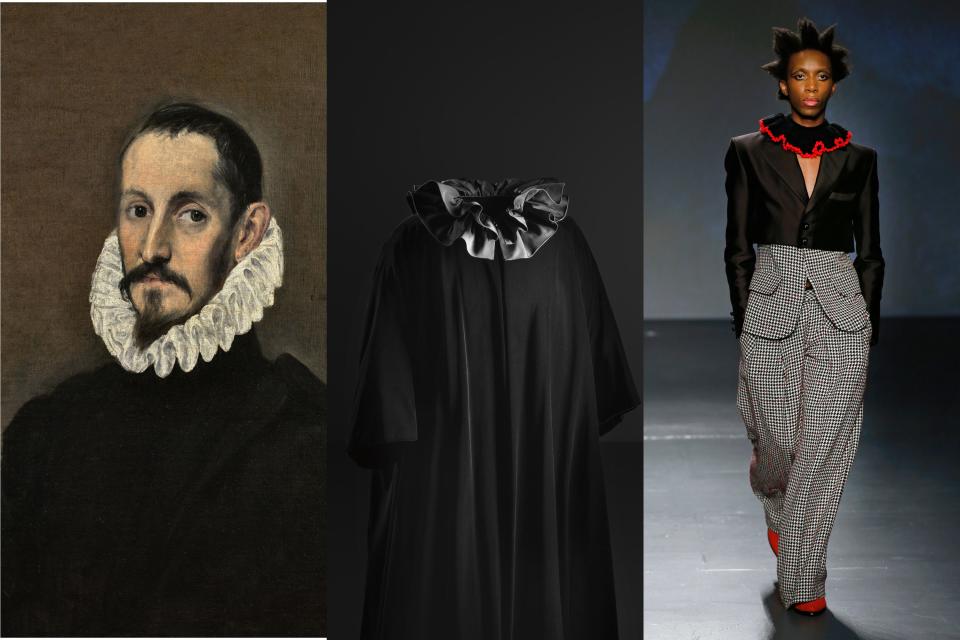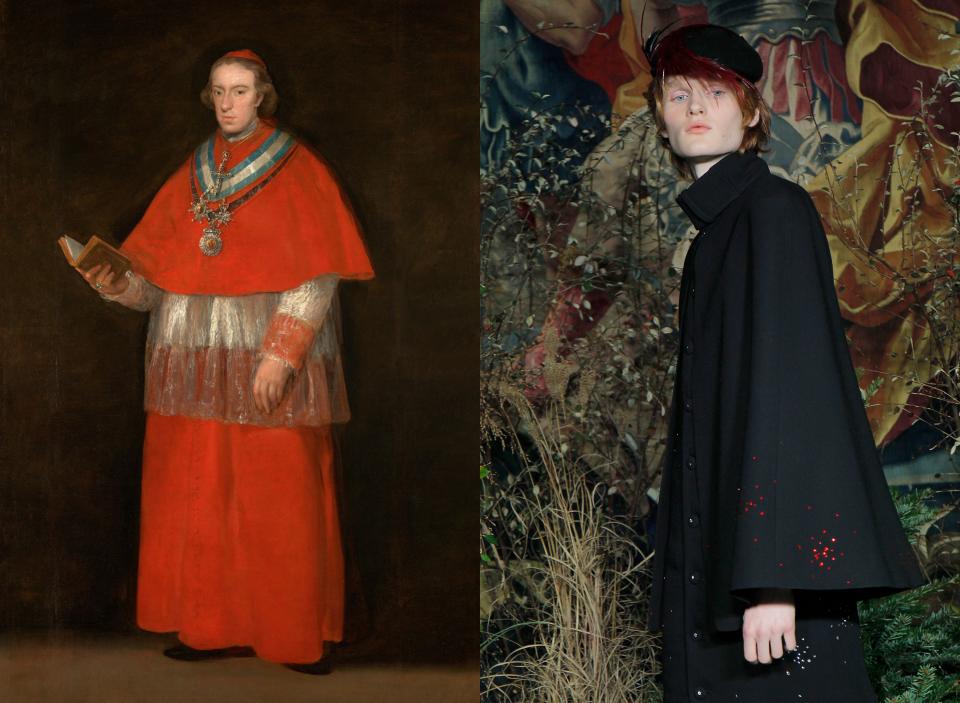Palomo on Balenciaga: The Hotshot Spanish Designer Spends a Day at the Museum with Vogue
![“I’m definitely obsessed by the drama and the almost surreal world of El Greco who painted a dimension in between the real and the divine, and I can see how my work also lives in this dimension.
Color was very significant in the work of El Greco; he displayed an absolutely wonderful technique [when] painting fabrics like taffetas and satins, and created the most beautiful draped volumes. In the work of Balenciaga we can also see the importance of color and the richness of the fabrics. Balenciaga was very much inspired by the work of the greatest painters of El Prado, and I think that inevitably relates to my work.”
Anunciación, by El Greco,1576, (left); Palomo Spain’s Spring 2019 Campaign.](https://s.yimg.com/ny/api/res/1.2/96bhHEXLiFCynTNd1yGWQw--/YXBwaWQ9aGlnaGxhbmRlcjt3PTEyNDI7aD05MTA-/https://media.zenfs.com/en/vogue_137/d33f8ddd700eb65471b483b85dd167eb)
“I’m definitely obsessed by the drama and the almost surreal world of El Greco who painted a dimension in between the real and the divine, and I can see how my work also lives in this dimension.
Color was very significant in the work of El Greco; he displayed an absolutely wonderful technique [when] painting fabrics like taffetas and satins, and created the most beautiful draped volumes. In the work of Balenciaga we can also see the importance of color and the richness of the fabrics. Balenciaga was very much inspired by the work of the greatest painters of El Prado, and I think that inevitably relates to my work.”
Anunciación, by El Greco,1576, (left); Palomo Spain’s Spring 2019 Campaign.
“It could have been much worse,” said Alejandro Gómez Palomo in response to me teasing him about his renown. Fans young and old had stopped the 27-year-old designer as we walked through the “Balenciaga and Spanish Painting” exhibition at the Thyssen-Bornemisza Museum in Madrid last month. (Read Hamish Bowles’s definitive review of the exhibit here). Palomo’s trajectory has been nothing less than meteoric: Though he’s shown only eight collections, he’s a household name in Spain. His work has been exhibited at the Costume Institute in New York, and he’s electrified the menswear industry with his baroque and gender-bending aesthetic and his army of dewy “Palomo boys.”
The designer’s path—small-town guy makes it in New York and Paris—might seem like a variation on the American dream, but Palomo’s work, like that of Cristóbal Balenciaga, is deeply rooted in Spanish history and tradition. “I’m not trying to be the most global Andalusian,” the designer said in a recent mini-doc, “but inevitably I go back to my heritage.”
Palomo is based in Spain, as Balenicaga was for almost half of his career. But where Balenciaga aimed for an almost monastic purity in his work, Palomo is a peacocking maximalist who’s never met a flounce he didn’t like. There were plenty of them on show in the Thyssen-Bornemisza exhibition, the best of which had Palomo exclaiming “Ridiculous!” (as in bad meaning good)—his highest form of praise.
Palomo talked to Vogue Runway about his homecoming, gender, and his famous Spanish predecessor.
What are your first impressions of the show?
It’s a beautiful experience...to have such an intimate, close view with both the clothes and the paintings. I know art and fashion are completely different things, but you see his work is just so obsessive [that] it almost takes it to the category of art. You want to look at it for a good amount of time and make your own reflection about it, look at the little details, look at the way it’s made—almost like looking at the trace of the brush of a painting, you know. It’s just very incredible to see.
In his introduction to the show this morning, the curator spoke of Balenciaga as a rule breaker. You, too, are making a revolution in fashion. Can you speak to this shared approach?
Well, first I would say this “revolution” was never something very intentional. When I started, I never had a speech made about gender, really. It was just something that I made naturally by observing what I was needing and what my friends around me were feeling. We started buying vintage, and we’d buy Christian Lacroix woman and put it on a man—it was just a matter of does it fit or not? I think with my generation, or my point of view, we unlocked all these gender things already, no? There doesn’t necessarily need to be a whole explanation about it. So [this revolution] wasn’t really intentional.
I would never compare myself to Balenciaga, but I think what he did, breaking all these rules, and doing it from a very simple, elegant, delicate, classic, almost minimalist way—I think that’s the whole revolution of it, no? That you make something so extraordinary by making it so simple.

“Ecclesiastical vestments and aesthetics have marked many of the silhouettes of Balenciaga. They wrap a woman’s body without compressing it, leaving freedom of movement within the costume. The cardinals and other powerful leaders in the hierarchy of the Roman Catholic Church has always been a reference in haute couture, this undoubtedly is also a space that I visit often in my research, and that has influenced my way of appreciating beauty since I was a child.”
El Greco, Portrait of a Gentleman (left); Balenciaga evening coat with ruffled collar, velvet and faille (middle); Palomo Spain, Fall 2019 (left).
You allude to Balenciaga’s obsessiveness—what’s yours?
In Spain, we’ve got a great history of art, no? We’ve got painters like Velasquez; he’s probably one of my greatest influences. I could spend hours and hours at El Prado, looking at all these pictures. It feels like our history has been richer and grander than [it is] nowadays, and we really need to look back to understand who we are and project a beautiful future—or what I imagine to be the future. Yesterday I was talking to someone about [a] handmade future. This is how I imagine it, looking at history and looking at how rich fashion’s been through history and looking at how we dress right now. It’s all become so simple, and fashion’s lost a lot of interest [to] regular people who don’t understand the quality of it anymore. I think what I do has to really be different from what you can get in fast fashion or that you can get every day to wear: There needs to be a real story behind it. I think my brand really looks at history and kind of gets all the Spanish crafts together. It’s something that looks so traditional and so Spanish, but at the same time, it’s modern because of the way it’s conceived.
Men were peacocks for a very long time….
Absolutely. I said it in the documentary: It’s not that I am inventing anything, but I think I’m lucky enough to do this for men that can enjoy fashion. I feel like we should enjoy fashion again, no? And it’s a beautiful moment to do that, and I think it’s the right time to do that as well. I’m so happy to be part of this movement of men changing the way of looking at fashion.
In what ways do you think Balenciaga’s work—and yours—is typically Spanish?
I think what unites both our worlds and makes the link is that we both started from the dressmaking world. Balenciaga comes from the Basque country, and he started making dresses for the aristocrats. He was dressing real women, elegant women. The way I started was very much the same; I started in my village, and I started with a seamstress that was making dresses for the wealthy ladies of the village, and we started looking at my work from her point of view, [which was] very traditional dressmaking, and very perfect handmade finishing—you’ve seen all those buttonholes and things like that. It’s what I think that links us the most: the love that you put in a piece that is completely handmade.
Like Balenciaga, you work at a remove from the so-called fashion capitals. Why?
It’s connected to intuition and family. I think we live in a very polluted world, in the way that we all get a lot of constant information, constant attention, and constant judgments as well, no? And I think it’s a matter of feeling comfortable and feeling at home and feeling protected where you can kind of blossom. I never expected to end up working in my village; I really wanted to run away when I was 18. I went to London and lived there for six years, and when I started to come back, I was like: What a beautiful life we have here, why [didn't] I realize [it] when I was a teenager? How lucky I am to live in a village where it’s sunny most of the year and it’s very quiet with beautiful surroundings. I’ve got all of my family here, and I can meet people in five minutes, while in London I spent all of the time by myself. I just felt that my village was a kind of environment in which to create something that was unique.
In every interview, I get [the question] “Aren’t you afraid of all this success?” and I’m like, I haven’t seen success really yet. Success comes, you know, like [with] Balenciaga, after 50 or 60 years of work, and then you have an exhibition at the Met or whatever. Success [is] relatively small in my career; I’ve only been around for three years and a half. Of course I have pieces at the Met and things like that, but I still have a lot to work on in the structure of the company. It’s a beautiful journey, and now we’re getting real, and we’re getting serious.

“I take a lot of inspiration from the Spanish Baroque period. I love the excess, the duskiness, the dark backgrounds, the exaggerated passion, the opulence, the decadence…. The color black is something I investigated in my last Fall collection; I’m realizing that the power of black is that it can sometimes say more than all other colors together. In Spain, black clothes have been so present throughout history and culture, from the portraits of El Greco to the widows portrayed by Jose Achiagam. The color is a symbol of chastity and mourning, but also one of the pillars of elegance, and I think Balenciaga liked to play between the concepts of austerity and pure luxury.”
Francisco de Goya, Cardinal Luis Maria de Borbón y Vallabriga, 1800, (left); a look by Palomo Spain (right).
*This interview has been edited and condensed for clarity.*L
Originally Appeared on Vogue

